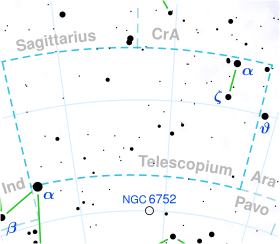HD 177693 (HR 7233; 48 G. Telescopii) is a solitary orange-hued star located in the southern constellation Telescopium. It has an apparent magnitude of 6.45,[2] placing it near the limit for naked eye visibility, even under ideal conditions. Gaia DR3 parallax measurements imply a distance of 376 light-years,[1] and it is drifting closer with a heliocentric radial velocity of −20.9 km/s.[6] At its current distance, HD 177693's brightness is diminished by 0.24 magnitudes due to interstellar extinction[13] and it has an absolute magnitude of +1.03.[7]
| Observation data Epoch J2000.0 Equinox J2000.0 (ICRS) | |
|---|---|
| Constellation | Telescopium |
| Right ascension | 19h 08m 52.32474s[1] |
| Declination | −55° 43′ 13.5297″[1] |
| Apparent magnitude (V) | 6.45±0.01[2] |
| Characteristics | |
| Spectral type | K1 III[3] or K1 IV[4] |
| B−V color index | +1.10[5] |
| Astrometry | |
| Radial velocity (Rv) | −20.9±2.9[6] km/s |
| Proper motion (μ) | RA: +56.586 mas/yr[1] Dec.: −115.876 mas/yr[1] |
| Parallax (π) | 8.6669 ± 0.0269 mas[1] |
| Distance | 376 ± 1 ly (115.4 ± 0.4 pc) |
| Absolute magnitude (MV) | +1.03[7] |
| Details | |
| Mass | 1.25[8] M☉ |
| Radius | 10.6[9] R☉ |
| Luminosity | 50.2+0.4 −0.3[1] L☉ |
| Surface gravity (log g) | 2.52[8] cgs |
| Temperature | 4,750±122[10] K |
| Metallicity [Fe/H] | −0.10[8] dex |
| Rotational velocity (v sin i) | <1.3[11] km/s |
| Other designations | |
| Database references | |
| SIMBAD | data |
HD 177693 has a stellar classification of K1 III,[3] indicating that it is an evolved orange giant. David Stanley Evans gave a less evolved class of K1 IV,[4] instead indicating that it is a slightly evolved subgiant. It has 1.25 times the mass of the Sun[8] but it has expanded to 10.6 times the radius of the Sun.[9] It radiates 50.2 times the luminosity of the Sun[1] from its enlarged photosphere at an effective temperature of 4,750 K.[10] HD 177693 is slightly metal deficient with an iron abundance of [Fe/H] = −0.10[8] and it spins with a projected rotational velocity lower than 1.3 km/s.[11]
References
edit- ^ a b c d e f g Vallenari, A.; et al. (Gaia collaboration) (2023). "Gaia Data Release 3. Summary of the content and survey properties". Astronomy and Astrophysics. 674: A1. arXiv:2208.00211. Bibcode:2023A&A...674A...1G. doi:10.1051/0004-6361/202243940. S2CID 244398875. Gaia DR3 record for this source at VizieR.
- ^ a b Høg, E.; Fabricius, C.; Makarov, V. V.; Urban, S.; Corbin, T.; Wycoff, G.; Bastian, U.; Schwekendiek, P.; Wicenec, A. (March 2000). "The Tycho-2 catalogue of the 2.5 million brightest stars". Astronomy and Astrophysics. 355: L27–L30. Bibcode:2000A&A...355L..27H. ISSN 0004-6361. S2CID 17128864.
- ^ a b Houk, N.; Cowley, A. P. (1975). University of Michigan Catalogue of two-dimensional spectral types for the HD stars: Declinations −90° to −53°. Vol. 1. Bibcode:1975mcts.book.....H.
- ^ a b Evans, D. S. (1966). "Fundamental data for Southern stars (6th list)". Royal Greenwich Observatory Bulletins. 110: 185. Bibcode:1966RGOB..110..185E.
- ^ Johnson, H. L.; Mitchell, R. I.; Iriarte, B.; Wisniewski, W. Z. (1966). "UBVRIJKL Photometry of the Bright Stars". Communications of the Lunar and Planetary Laboratory. 4: 99–110. Bibcode:1966CoLPL...4...99J.
- ^ a b c Gontcharov, G. A. (November 2006). "Pulkovo Compilation of Radial Velocities for 35,495 Hipparcos stars in a common system". Astronomy Letters. 32 (11): 759–771. arXiv:1606.08053. Bibcode:2006AstL...32..759G. doi:10.1134/S1063773706110065. eISSN 1562-6873. ISSN 1063-7737. S2CID 119231169.
- ^ a b Anderson, E.; Francis, Ch. (May 2012). "XHIP: An extended hipparcos compilation". Astronomy Letters. 38 (5): 331–346. arXiv:1108.4971. Bibcode:2012AstL...38..331A. doi:10.1134/S1063773712050015. eISSN 1562-6873. ISSN 1063-7737. S2CID 119257644.
- ^ a b c d e Anders, F.; et al. (February 2022). "Photo-astrometric distances, extinctions, and astrophysical parameters for Gaia EDR3 stars brighter than G = 18.5". Astronomy & Astrophysics. 658: A91. arXiv:2111.01860. Bibcode:2022A&A...658A..91A. doi:10.1051/0004-6361/202142369. eISSN 1432-0746. ISSN 0004-6361.
- ^ a b McDonald, I.; Zijlstra, A. A.; Watson, R. A. (15 June 2017). "Fundamental parameters and infrared excesses of Tycho–Gaia stars". Monthly Notices of the Royal Astronomical Society. 471 (1): 770–791. arXiv:1706.02208. Bibcode:2017MNRAS.471..770M. doi:10.1093/mnras/stx1433. eISSN 1365-2966. ISSN 0035-8711. S2CID 73594365.
- ^ a b Stassun, Keivan G.; et al. (9 September 2019). "The Revised TESS Input Catalog and Candidate Target List". The Astronomical Journal. 158 (4): 138. arXiv:1905.10694. Bibcode:2019AJ....158..138S. doi:10.3847/1538-3881/ab3467. eISSN 1538-3881. hdl:1721.1/124721. S2CID 166227927.
- ^ a b De Medeiros, J. R.; Alves, S.; Udry, S.; Andersen, J.; Nordström, B.; Mayor, M. (January 2014). "A catalog of rotational and radial velocities for evolved stars V: Southern stars *". Astronomy & Astrophysics. 561: A126. arXiv:1312.3474. Bibcode:2014A&A...561A.126D. doi:10.1051/0004-6361/201220762. eISSN 1432-0746. ISSN 0004-6361. S2CID 54046583.
- ^ "HD 177693". SIMBAD. Centre de données astronomiques de Strasbourg. Retrieved September 11, 2023.
- ^ Gontcharov, George A.; Mosenkov, Aleksandr V. (28 September 2017). "Verifying reddening and extinction for Gaia DR1 TGAS main sequence stars". Monthly Notices of the Royal Astronomical Society. 472 (4): 3805–3820. arXiv:1709.01160. Bibcode:2017MNRAS.472.3805G. doi:10.1093/mnras/stx2219. eISSN 1365-2966. ISSN 0035-8711. S2CID 118879856.
